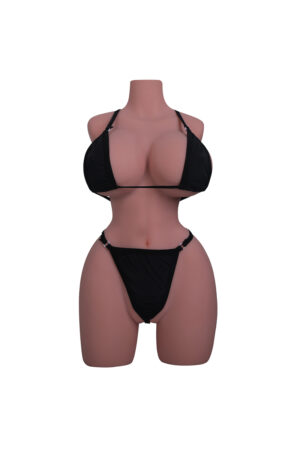
La verità tattile
Quando giudichiamo se qualcosa si sente “vero,” il nostro senso del tatto spesso parla più forte dei nostri occhi. Ciò è particolarmente vero per i compagni intimi come le bambole del sesso, Dove il realismo dipende non solo su come appare una figura, Ma come ci si sente al tatto. Bambole full-figurate, con le loro curve morbide e contorni che producono, Supera costantemente le alternative più sottili nel realismo percepito - e questa non è una questione di preferenza da sola. C'è una base scientifica dietro il motivo per cui un più morbido, Il corpo più pieno innesca il nostro cervello “realtà” Detector in modo più efficace.
La nostra pelle è l'organo sensoriale più grande del corpo, Ricco di recettori che rilevano la pressione, temperatura, e trama. Questi recettori si sono evoluti per riconoscere i segnali sottili del contatto umano: il dono dei tessuti molli, la distribuzione irregolare del peso, il calore della carne vivente. Le bambole full-figured sono progettate per imitare questi segnali, Sfruttare i materiali, peso, e struttura per creare un'esperienza tattile che si allinea alla comprensione radicata del nostro cervello di “umano.”
Questo articolo esplora la scienza della morbidezza, Abbattere il modo in cui la composizione del materiale, distribuzione del peso, e le associazioni psicologiche si combinano per far sentire le figure più piene più realistiche - e perché questo conta per la nostra esperienza di connessione.
Composizione del materiale e ammortizzazione
Il realismo di una figura più piena inizia con i suoi materiali, in particolare, Come replicano la trama complessa e la reattività dei tessuti molli umani. A differenza delle bambole più sottili, che spesso dà la priorità a fermezza e definizione, Le bambole più fulle usano compositi avanzati progettati per imitare la sensazione di adipose (grasso) tessuto, muscolo, e pelle.
Al centro, Le bambole più piene di alta qualità presentano una struttura a strati: Un frame interno robusto ma flessibile (di solito metallo o plastica durevole) avvolto in schiuma o gel “carne” strato, quindi coperto da una pelle finale di silicone o TPE di livello medico (elastomero termoplastico). Questa stratificazione è fondamentale. La schiuma o il gel imita la ammortizzazione del grasso - abbastanza morbido da comprimere sotto pressione ma con abbastanza resilienza per tornare alla sua forma, Proprio come il vero tessuto adiposo. Il silicone o TPE esterno aggiunge una consistenza simile alla pelle: leggermente poroso, con una sottile finitura opaca che resiste al artificiale “scivoloso” di materiali più economici.
Questa composizione crea un unico “Effetto ammortizzante” Quelle bambole più sottili spesso mancano. Quando premi una mano contro la pancia o la coscia di una bambola più piena, Il materiale si comprime gradualmente, con diversi livelli di resistenza - più dare al centro, più solido ai bordi, rispecchiando come si comporta il vero tessuto morbido. Bambole più sottili, con la loro attenzione su muscoli definiti e linee angolari, utilizzare materiali più densi che offrano una resistenza uniforme, sentirsi più come una struttura rigida avvolta nella pelle che come un essere vivente, corpo che respira.
Neurologicamente, questo è importante. I nostri recettori tattili sono sensibili a queste sottili variazioni di pressione e resistenza. Quando rilevano il graduale cedimento del materiale di una bambola più piena, inviano segnali al cervello che si allineano con i ricordi del contatto umano, innescando un riconoscimento subconscio di “realtà” quell'uniforme, i materiali solidi non possono replicarsi.
Distribuzione del peso e realismo
Il peso non è solo questione di peso, ma di come viene distribuito, e le bambole a figura intera eccellono qui rispecchiando le naturali irregolarità del corpo umano. I nostri corpi non sono uniformemente densi; grasso, muscolo, e l'osso creano sacche di leggerezza e pesantezza. Una cifra più completa, con la sua enfasi sui tessuti molli, replica questo squilibrio in modi che fanno sentire viva la bambola.
Le bambole più magre in genere hanno una distribuzione del peso più uniforme, con le loro strutture e materiali densi che creano un aspetto coerente “leggerezza” attraverso il corpo. Questo può sembrare innaturale: membra umane, Per esempio, sono più pesanti sulle cosce e sulla parte superiore delle braccia, più leggero ai polsi e alle caviglie. Bambole più piene, per contrasto, concentrare il peso nelle aree in cui i corpi reali lo trasportano: i fianchi, gonfiarsi, e cosce – mantenendo gli arti proporzionalmente più leggeri. Questo crea un effetto naturale “ondeggiare” quando la bambola viene spostata, simile a come il corpo di una persona si sposta quando cammina o si posiziona.
Questa distribuzione non uniforme influisce anche sul modo in cui la bambola interagisce con il suo ambiente. Una bambola più piena, quando seduto, Volere “lavello” leggermente su una sedia, con i fianchi e le cosce che si comprimono più della parte inferiore delle gambe, proprio come una persona reale. Quando sollevato, il peso si sposta tra le tue braccia, richiede sottili aggiustamenti per mantenere l’equilibrio, rispecchiando ancora una volta il contatto umano. Questi movimenti attivano il sistema vestibolare del nostro cervello (che governa l’equilibrio e la consapevolezza spaziale), rafforzando la percezione che stiamo interagendo con un vivente, essere fisico.
Insomma, la distribuzione del peso in cifre più complete non è solo una questione di sentimento “pesante” – è una questione di sentimento umanamente pesante, con tutte le deliziose irregolarità che ciò implica.
Il conforto psicologico della morbidezza
Il realismo di una figura più completa non è solo fisico: è psicologico. Il nostro cervello è programmato per associare la morbidezza alla sicurezza, calore, e l'umanità, rendendo più morbido, i corpi più pieni si sentono di più “vero” a livello emotivo.
La psicologia dello sviluppo offre spunti qui: fin dall'infanzia, colleghiamo la morbidezza dell'abbraccio di un caregiver al comfort e alla sicurezza. Questa associazione è cablata, con studi che dimostrano che toccare le texture morbide innesca il rilascio di ossitocina (IL “ormone legante”) e riduce l'attività nell'amigdala (il centro della paura del cervello). Le bambole a figura intera attingono a questa connessione profonda, le loro curve morbide attivano gli stessi percorsi neurali del contatto umano.
Questo conforto psicologico migliora il realismo percepito in due modi. Primo, abbassa le nostre difese: quando ci sentiamo al sicuro, è più probabile che il nostro cervello accetti la bambola come una bambola “vero” presenza, invece di liquidarlo come un oggetto. Secondo, crea un ciclo di feedback: più ci sentiamo a nostro agio, più ci impegniamo con la bambola (abbracciare, toccante, interagendo), e più dati sensoriali ricevono il nostro cervello per confermarlo “realtà.”
Bambole più sottili, con le loro linee spigolose e texture più solide, spesso non riescono a innescare questa risposta. La loro estetica può essere sorprendente, ma manca della morbidezza che il nostro cervello associa al calore umano, lasciandoli più come sculture che come compagni. Cifre più complete, per contrasto, Tatto “accessibile” a livello primordiale, rendendo più facile sospendere l’incredulità e sperimentare una connessione autentica.
Il realismo delle curve
Il realismo di una figura più completa non è un incidente: è un prodotto della scienza, ingegneria, e la comprensione innata del nostro cervello del contatto umano. Dai materiali stratificati che imitano il cedimento dei tessuti molli alla distribuzione irregolare del peso che rispecchia il movimento umano, ogni aspetto di una bambola più piena è progettato per allinearsi alle nostre aspettative sensoriali “vero.”
Ma forse il fattore più potente è psicologico: la nostra profonda associazione tra morbidezza e umanità. Le figure più complete non solo assomigliano di più ai corpi reali, ma si sentono come loro, innescando le stesse risposte neurali del tocco umano e favorendo un senso di connessione più solido, le alternative più snelle non possono eguagliare.
Alla fine, la scienza della morbidezza ci dice quello che molti già intuiscono: il realismo non riguarda la perfezione. Riguarda l'imperfezione: la morbidezza della pancia, il peso irregolare di una coscia, il calore di un corpo che sembra possa appartenere a qualcuno. Le figure più complete abbracciano queste qualità, e così facendo, si avvicinano alla verità di cosa significhi sentire “vero.”

























